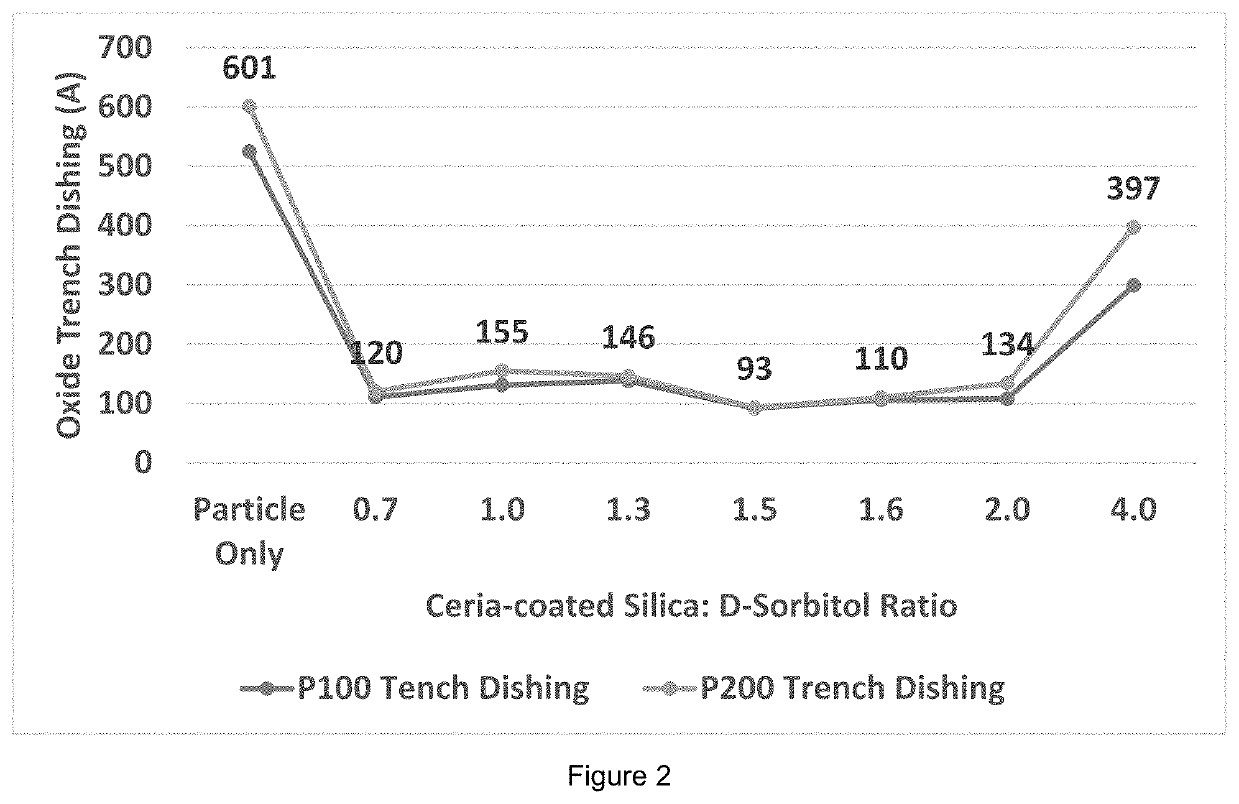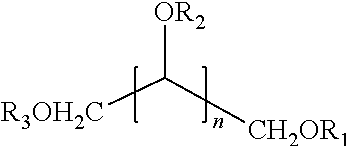Low Oxide Trench Dishing Chemical Mechanical Polishing
a technology of chemical mechanical polishing and low oxide trench dishing, which is applied in the direction of other chemical processes, chemistry apparatus and processes, electrical equipment, etc., can solve the problems of non-uniform trench oxide loss across dies, affecting transistor performance and device fabrication yields, and device failure, so as to reduce additives, reduce oxide trench dishing, and improve over polishing window stability
- Summary
- Abstract
- Description
- Claims
- Application Information
AI Technical Summary
Benefits of technology
Problems solved by technology
Method used
Image
Examples
working examples
[0157]In the following working examples, a polishing composition comprising 0.2 wt. % cerium-coated silica, a biocide ranging from 0.0001 wt. % to 0.05 wt. %, and deionized water was prepared as reference (ref.).
[0158]The polishing compositions were prepared with the reference (0.2 wt. % cerium-coated silica, a biocide ranging from 0.0001 wt. % to 0.05 wt. %, and deionized water) plus a chemical additive in 0.01 wt. % to 2.0 wt. %.
[0159]All examples, except pH condition examples the composition had a pH at 5.35.
[0160]pH adjusting agent used for acidic pH condition and alkaline pH condition were nitric acid and ammonium hydroxide respectively.
example 1
[0161]The working slurries has 0.15 wt. % chemical additives added to the reference slurry.
[0162]The effects of various selected chemical additives on the film removal rates and selectivity were observed.
[0163]The removal rates (RR at Å / min) for different films were tested. The test results were listed in Table 1.
TABLE 1Effects of Chemical Additives on FilmRR (A / min.) & TEOS: SiN SelectivityTEOS-RRHDP-RRSiN-RRTEOS: SiNSamples(ang / min)(ang / min)(ang / min)Selectivity0.2 wt. % Ceria-coated327927183499Silica (Ref.)Ref. + 0.15 wt. %239422997532D-SorbitolRef. + 0.15 wt. %2741237212422D-MannitolRef. + 0.15 wt. %2839210414819D-(+)-MannoseRef. + 0.15 wt. %2694225610925XylitolRef. + 0.15 wt. %280820643668meso-Erythritol
[0164]As the results showed in Table 1, the slurries based on ceria-coated silica offered higher removal rate for TEOS.
[0165]As the results further showed in Table 1, the chemical additives D-sorbitol, D-mannitol, D-mannose, and xylitol, except meso-erythritol suppressed SiN remo...
example 2
[0166]In Example 2, 0.2 wt. % ceria-coated silica abrasive based formulation without chemical additives was used as reference.
[0167]The chemical additives were used at 0.15 wt. % (0.15×) concentrations respectively with 0.2 wt. % ceria-coated silica as abrasives in the working slurries.
[0168]The effects of various selected chemical additives on the oxide trenching dishing vs over polishing times were observed.
[0169]The test results were listed in Table 2. HDP RR (Å / min.) from Table 1 was also listed in Table 2.
TABLE 2Effects of Chemical Additives on Oxide Trench Dishing & HDP RR (A / min.)Blanket HDP RRCompositionsOP Time (sec.)100 um pitch dishing200 um pitch dishing(A / min.)0.2% Ceria-coated Silica pH 5.3501652912718608571096120120715310.2% Ceria-coated Silica + 0.15X D-Sorbitol01372762299602474111203805440.2% Ceria-coated Silica + 0.15X D-mannitol01622852372603685801205638160.2% Ceria-coated Silica + 0.15X D-(+)-01812722401Mannose60660973120112115530.2% Ceria-coated Silica + 0.15X X...
PUM
 Login to View More
Login to View More Abstract
Description
Claims
Application Information
 Login to View More
Login to View More - R&D
- Intellectual Property
- Life Sciences
- Materials
- Tech Scout
- Unparalleled Data Quality
- Higher Quality Content
- 60% Fewer Hallucinations
Browse by: Latest US Patents, China's latest patents, Technical Efficacy Thesaurus, Application Domain, Technology Topic, Popular Technical Reports.
© 2025 PatSnap. All rights reserved.Legal|Privacy policy|Modern Slavery Act Transparency Statement|Sitemap|About US| Contact US: help@patsnap.com



